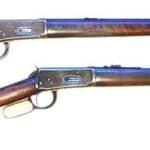
The Thompson Submachine Gun, commonly known as the 'Tommy Gun,' is an iconic piece of American firearm history. Named after its inventor, John T. Thompson, it became an emblem of the roaring twenties gangster era and World War II. The Thompson Submachine Gun had several variations, with the M1928A1 being a noteworthy model due to its extensive use during World War II.
The Development and Predecessors
Before the Thompson Submachine Gun came to fruition, John T. Thompson, a former U.S. Army officer, had envisioned an "auto rifle" to replace the bolt-action service rifles then in use. In 1915, he founded the Auto-Ordnance Corporation to develop this idea.
Unfortunately, the recoil-operated weapon design he pursued was not successful. Thompson then turned to the Blish Lock system, patented by Navy Commander John Bell Blish, which used metallic adhesion under pressure to delay the breech's opening. In 1919, Thompson's team developed the Thompson Submachine Gun, which became the first weapon to be labeled a "submachine gun."
The M1928A1 Model
The M1928A1, manufactured in 1928, was an improvement on the initial design. It boasted a heavier actuator, a semi and full-automatic option, and a simplified rear sight. Unlike the earlier models, which had top-mounted charging handles, the M1928A1 had a side-mounted charging handle.
The Thompson also featured a Cutts compensator, a device designed to counter muzzle rise during automatic fire. Another notable feature was the compatibility with both 20-round box magazines and 50-round drum magazines, offering greater flexibility to the operator.
Manufacture and Production
The original manufacturer of the Thompson Submachine Gun was the Auto-Ordnance Corporation, founded by Thompson himself. Early Thompson models struggled to find a market, given their high cost and the relative peace of the late 1920s and early 1930s.
However, the outbreak of World War II dramatically changed the firearm's fortunes. The M1928A1 was adopted by the U.S. military in 1940, and demand quickly outpaced Auto-Ordnance's production capabilities.
To meet this demand, contracts were awarded to the Savage Arms Company and the Colt's Manufacturing Company. In total, over 1.5 million Thompson Submachine Guns were produced between 1940 and 1945, with the M1928A1 being the most common variant.
Cartridges and Performance
The Thompson Submachine Gun, including the M1928A1, was chambered for the .45 ACP (Automatic Colt Pistol) cartridge, a powerful round developed by John Browning in 1905 for his new Colt semi-automatic pistol. This round was widely adopted by the U.S. military and offered considerable stopping power.
The Thompson M1928A1, with a 10.5-inch barrel, had a rate of fire of approximately 600-725 rounds per minute and was effective to a range of about 50 meters in automatic mode, but could reach up to 150 meters in semi-automatic.
Use and Deployment
The M1928A1 saw widespread use during World War II by U.S. and Allied forces. U.S. soldiers and Marines used the weapon extensively in both the European and Pacific theatres.
Moreover, the British Army and the Canadian Army also used the Thompson. Under the Lend-Lease agreement, over 500,000 Thompsons were shipped to the UK, where they were favored by Commando units
.
The weapon was popular due to its reliability, the stopping power of the .45 ACP cartridge, and the high volume of fire it could produce. However, it was also heavy and expensive to manufacture, leading to its eventual replacement by lighter and cheaper designs.
Comparison to Other Battle Rifles
During World War II, the M1 Garand was the standard service rifle for U.S. troops, while the M1 Carbine was also widely issued. Both of these weapons were semi-automatic, but they fired more powerful rounds and had a longer effective range than the Thompson.
Among the Allies, the British primarily used the bolt-action Lee-Enfield No. 4 Mk I rifle, which was renowned for its reliability and accuracy. The Soviet Red Army was equipped with the semi-automatic Tokarev SVT-40 and the Mosin-Nagant 1891/30, a bolt-action rifle.
The Axis powers also used a mix of bolt-action and semi-automatic rifles. The German Wehrmacht was largely equipped with the bolt-action Karabiner 98k, but semi-automatic rifles like the Gewehr 41 and Gewehr 43 were also in use.
While the Thompson M1928A1 was more akin to a personal defense weapon, its role on the battlefield was unique. It was ideally suited for close-quarters combat, such as clearing trenches or urban warfare, where its high rate of fire gave U.S. and Allied soldiers a considerable advantage.
Conclusion
The Thompson M1928A1 Submachine Gun, despite its weight and manufacturing cost, played a critical role in World War II. It demonstrated the effectiveness of submachine guns in modern warfare and set a precedent for future designs. It remains a symbol of American ingenuity and resilience, an iconic firearm with an indelible place in history.
To read more about the Thompson and discuss with other enthusiasts, join the forums here.
If you know of any forums or sites that should be referenced on this listing, please let us know here.




